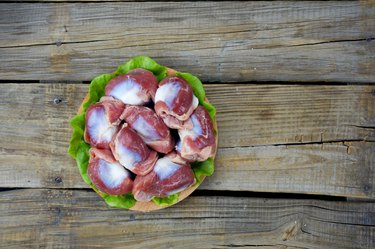
When it comes to protein choices, most Americans choose chicken more often than beef, pork, turkey or fish, according to the National Chicken Council. While you might be eating chicken, you're probably not eating chicken gizzards and hearts. Gizzard and chicken heart nutrition might surprise you.
If you're not familiar with the gizzard, it's the muscle in the chicken that grinds food before it is digested. Like other parts of the chicken, the hearts and gizzards are a good source of protein, but are higher in fat and cholesterol than light meat chicken.
Video of the Day
Video of the Day
Read more: The Health Benefits of Gizzards
Gizzards and Chicken Heart Nutrition
If you're looking to save calories, the gizzards make a better choice. One cup of simmered chicken hearts contains 268 calories, while the same portion of simmered chicken gizzards contains 223 calories, according to USDA FoodData Central.
Even though there is a 45-calorie difference between the two meats, both the chicken hearts and gizzards are low-energy-dense foods, which means their calorie content is low when compared to their weight.
Props for Protein
High-quality protein content is one of the health benefits of chicken hearts and gizzards. Both the chicken hearts and gizzards are high in protein, but the gizzards are slightly higher than the hearts.
A 1-cup portion of simmered chicken hearts contains 38.3 grams of protein, and the same portion of simmered chicken gizzards contains 44.1 grams. These meat choices go a long way toward meeting the recommended 46 grams per day for women and 56 grams for men, according to the National Academies of Sciences.
As an animal protein, both the hearts and gizzards provide all the essential amino acids, making it a complete source of protein. Protein is found in every cell in your body, and the protein in your diet is used to help replace and maintain protein levels.
Watch the Fat Content
Although chicken hearts and gizzards are low in calories and high in protein, they are both high in cholesterol, and the chicken hearts are high in fat.
One cup of the hearts contains 11.5 grams of total fat, of which 3.28 grams are saturated, while a cup of chicken gizzards contains 3.89 grams of total fat — 0.97 grams are saturated fats. The National Academies of Sciences recommends that you limit your total fat intake to 20 to 35 percent of total calories.
According to the American Heart Association, no more than 5 to 6 percent of your daily fat intake should come from saturated fats. For example, if you consume 2,000 calories per day, that's a maximum of 13 grams of saturated fats. These macronutrients can increase your risk of some health conditions, such as heart disease.
Warning
While organ meats are a good source of protein, these foods should be avoided if you have certain medical conditions, such as gout. They can lead to a flare-up, according to the Arthritis Foundation.
Meet the Minerals
Both chicken hearts and gizzards are high in iron and zinc, but the hearts are the better source. A 1-cup portion of chicken hearts contains 13.1 milligrams of iron and 10.6 milligrams of zinc, while the gizzards contain 4.62 milligrams of iron and 6.41 milligrams of zinc, according to USDA FoodData Central.
Iron is needed to make hemoglobin and transport oxygen throughout your body. Zinc helps you fight colds by boosting your immune system, and also helps heal cuts.
- National Chicken Council: "Per Capita Consumption of Poultry and Livestock, 1965 to Forecast 2020, in Pounds"
- American Heart Association: "Know Your Fats"
- USDA FoodData Central: "Chicken, Gizzards, All Classes, Cooked, Simmered"
- USDA FoodData Central: "Chicken, Heart, All Classes, Cooked, Simmered"
- National Academies of Sciences: "Macronutrients"
- Arthritis Foundation: "Gout Diet: Do's and Don'ts"